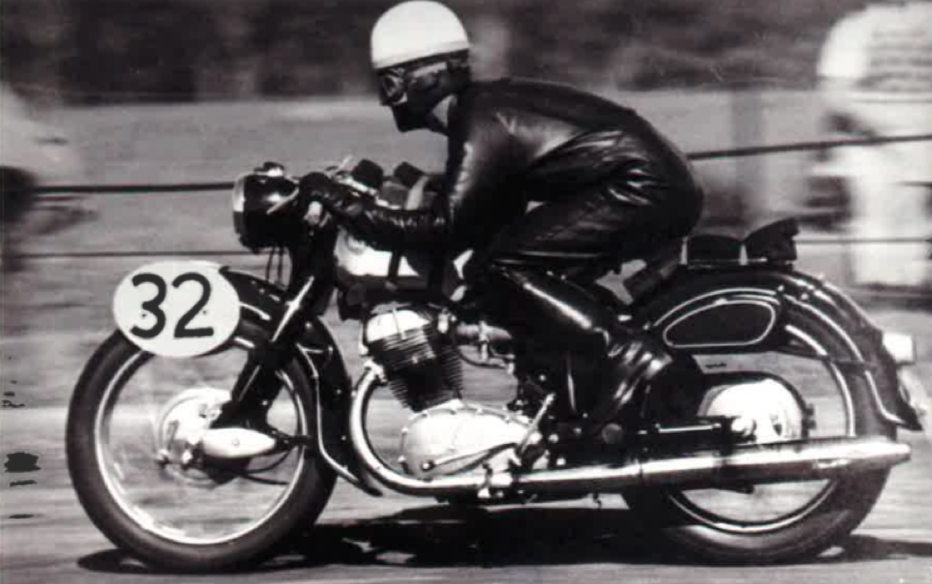The world’s first 24-hour proddie race was not for the faint-hearted
Mount Druitt Marathon – AFTER the success of Australia’s first 24-hour production car race, exuberant Mount Druitt track promoter Belfred Jones hit up the NSW Auto Cycle Union with a proposal to hold the world’s longest production motorcycle race on the October long weekend 1954.
Initially the ACU was having none of it, citing non-existent crowd control around the 3.6km road circuit, poor lighting in the pit area, and a total lack of illumination elsewhere.
Then there was the road surface, which apart from the airstrip straight consisted of badly patched tar, riddled with potholes, camouflaged with blue metal and bordered by piles of scrap metal lurking in the knee-high grass.
Belfred’s proposal was seen as ludicrous – until he put up a thousand quid prizemoney, promised to clean up the scrap metal and patch the circuit. The 24 Hour enduro was scheduled to start at 2pm on 3 October.
Eight hours in, Tommy Farr’s AJS broadsided a cow, also bringing down Errol Thurston and Barry Halliday. The trio survived, though it took some time to remove the cow.
Later that night another bovine had to be mustered off the track.
With very few headlights functioning, it was a relief to many competitors when the leading Norton burst into flames during a pit stop and at least illuminated Pit Straight for some time due to a lack of fire extinguishers.
Dawn brought respite to all as competitors settled into a final grind that saw Jack Forrest’s BMW R68 complete 2330km to take the chequer.
Despite the problems, expectations for the 1955 24-hour race were buoyant. The ACU assured competitors the problem of animals on the circuit had been resolved, yet during night practice Len Roberts – a member of the 1954 winning team – suffered fatal injuries when he crashed avoiding a horse on the track.
Laurie Green, who teamed up with Ron Shearer and a 17-year-old Kel Carruthers on a 250 NSU, recalls that circuit safety was non-existent, but remembers a lap of Mount Druitt quite fondly.
“Down the hill, round the big sweeper, wheels sliding on the loose scree gravel, then onto the airstrip, being very careful not to drift out into the large dump of rusting scrap metal at the edge,” Green recalled.
“Hold it flat to the end of the strip, cut in close to the painted white tyres, into the dip with suspension bottoming, drift out to the edge of the tar, then chin on the tank up the hill, down through the cogs through Dam and Pit Straight corners before firing it down Pit Straight, watching the white blur of faces as you fly.
“As the big boys motored past, we had to try to tuck the little NSU into their slipstream – if we could stand the shower of blue-metal in the teeth. And it was a relief when the big Triumph thundered by, providing a flood of light for a few fleeting seconds.”
It was then that the two leading Triumphs had a coming together with a backmarker, resulting in a smashed muffler, burst tyre and three bikes down.
Next, Don Blackburn dropped his Velo, receiving fatal injuries when he was struck by several other bikes.
Over in the pits, a pressure lamp exploded and set fire to the building containing the fuel stores.
It was bedlam, yet when riders and officials met after the ‘clean up’ it was agreed to carry on.
Not for Carruthers, though. Much to the disappointment of the lad, his old man Jack – a noted speedway champion – pulled him out, leaving Laurie and Ron to do double duty on the NSU until dawn. The Woodyatt/Sluce/Sluce team on a Triumph Tiger 500 took the win with Green/Shearer/Carruthers taking the Lightweight class.
Despite the obvious dangers, Laurie Green sounds almost wistful: “The Mount Druitt 24 Hour was a race of great merit and tragedy, and you won’t see the likes of it again. Rules and regulations have made sure of that.”
By Peter Whitaker
